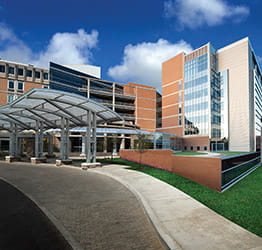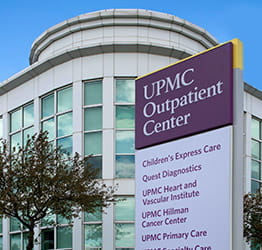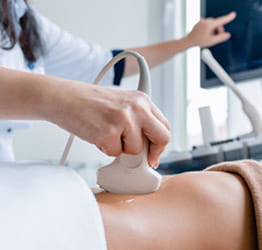What Is A Mammogram?
A mammogram is a safe, noninvasive x-ray of your breast tissue that creates images that are stored on a computer. A routine mammogram consists of a minimum of two views of each breast — one from the top and one from the side. Board-certified breast radiologists use these images to identify changes in breast tissue or detect breast cancer early, often before symptoms appear and when treatment is most effective.
How is 3D mammography different from 2D mammography?
2D mammography only takes one top-to-bottom picture and one side-to-side picture of your breast. 3D mammography — also called tomosynthesis — takes multiple pictures from different angles and uses a computer to combine them, giving doctors a view of each layer of breast tissue. At UPMC, nearly all routine mammograms are performed using 3D mammography technology.
What are the benefits of a 3D mammogram?
3D mammograms provide several benefits, including:
- Reducing the risk of false-positive or unclear results caused by overlapping or dense breast tissue. This reduces the need for recalls for additional testing after screening for findings that are not cancer.
- Slightly improved breast cancer detection compared to 2D digital mammograms alone.
Types of mammograms
There are two types of mammograms:
Screening mammogram
A screening mammogram is performed if you have no symptoms of breast disease. Women at average risk for breast cancer should begin annual screening mammography at age 40 and continue as long as they are in good health. Women at high risk for breast cancer should talk to their doctor about starting to get screening breast MRI as early as age 25 and screening mammograms as early as age 30.
If you have a family history of breast cancer, your doctor may recommend starting to get screening mammograms 10 years before the age at which your youngest relative was diagnosed with breast cancer, but not before age 30. For example, if your mother was diagnosed at age 45, your doctor may recommend that you start to have screening mammograms at age 35.
Even if you have had breast cancer or are at high risk, your routine mammogram should be performed as a screening mammogram as long as you are not having breast cancer symptoms. A screening mammogram appointment typically takes less than 30 minutes.
Your screening mammogram results will be reviewed along with any prior breast imaging results. You will typically receive your breast cancer screening results within a week, but it may take up to 30 days after your appointment to receive your results.
Diagnostic mammogram
A diagnostic mammogram is performed if you have symptoms of breast disease, such as a lump, nipple discharge, or other breast symptoms — or if you need follow-up care for an abnormality that was found on prior breast imaging or a screening mammogram.
After your diagnostic mammogram is complete, your breast radiologist will review your images while you wait in the breast imaging center and provide you with your results before you leave.
If needed, your breast imaging team will take additional mammography images or perform a targeted ultrasound exam during your appointment. As a result, diagnostic mammogram appointments may take up to two hours.
Conditions we diagnose with mammography
- Atypical ductal hyperplasia.
- Atypical lobular hyperplasia.
- Breast cancer.
- Breast cysts.
- Fibroadenomas.
- Fibroepithelial lesion.
- Flat epithelial atypia.
- Intraductal papilloma.
- Lobular carcinoma-in-situ.
- Microcalcifications.
- Mucocele-like lesion.
- Radial scar.
Why Would I Need A Mammogram?
You may need a mammogram if:
- You have no symptoms of breast disease, are over age 40, and/or are at higher-than-average risk of developing breast cancer and need a screening mammogram.
- You have symptoms of breast disease and need a diagnostic mammogram.
Who’s a candidate for mammography?
Mammography is safe for most women. If you have symptoms of breast disease, your doctor may recommend a diagnostic mammogram.
You may be a candidate for screening mammography if:
- You have no symptoms of breast disease.
- You are a woman over age 40.
- You are younger than age 40 and at high risk of developing breast cancer.
Screening mammograms are recommended for all women starting at age 40, even if no symptoms are present. Those with a family history of breast cancer, dense breasts, or breast implants may need earlier or more frequent screening.
What Are the Risks and Complications of Mammography?
Mammography is a safe, effective screening and diagnostic tool for most women. However, because mammography uses x-ray imaging technology, it involves exposure to a very small amount of radiation.
The radiation dose is highly regulated and considered to be safe. The amount of exposure during a mammogram is the same as the amount of radiation you would be naturally exposed to in the environment on a daily basis over several weeks. There is no reliable data to suggest that the radiation dose used during annual mammography is harmful.
If you have dense breasts, some cancers can be more difficult to see due to the density of your breast tissue. You should ask your doctor about whether you have dense breast tissue and need supplemental screening.
Can I have a mammogram when I am pregnant?
If you are pregnant and have symptoms of breast cancer, your doctor will typically order a breast ultrasound. Breast ultrasound is safe during pregnancy because it uses sound waves instead of radiation to create images of breast tissue.
If your ultrasound shows suspicious findings or if the clinical findings are concerning and you are over age 30, your doctor may recommend a mammogram.
If you are diagnosed with breast cancer, you should have a mammogram even if you are pregnant. There is a very small amount of scatter radiation exposure to the fetus, which has not been shown to cause harm. Radiation exposure can be further minimized by wearing a lead apron over your abdomen during your mammogram.
If you are over age 40 and are due for a screening mammogram while pregnant, you may choose to have your mammogram during pregnancy or postpone it until a few months after you stop breastfeeding.
What Should I Expect From A Mammogram?
Before: How to prepare for a mammogram
Making a mammogram appointment for a diagnostic mammogram
Before making an appointment for a diagnostic mammogram, you should find out if your health insurance plan requires a referral or preapproval. If so, your doctor will need to send an insurance referral or get preapproval.
Except for a recall after screening, you will need a prescription from your physician and you may owe a copayment.
Diagnostic mammogram appointments are made by speaking with a scheduler.
Making a mammogram appointment for a screening mammogram
Your health plan may make you wait one year and a day between screening mammograms. There is no copayment for routine screening mammograms after age 40.
You can schedule a screening mammogram appointment through the UPMC patient portal or by calling the UPMC Imaging Center location closest to you.
Before your mammogram
After you schedule your mammogram appointment and before you have your test, you should:
- Ask your doctor if you should take pain medicine, such as ibuprofen, to relieve minor discomfort related to breast compression.
- Avoid scheduling your exam near the time of your menstrual period.
- If you are a new UPMC patient or have had breast imaging at an outside facility, have the images and results of your prior mammogram, if applicable, sent to the imaging facility. If your previous mammogram was performed at UPMC, your provider should have access to your imaging results.
- Let your provider know if you have breast implants.
- Not wear deodorant, zinc-oxide ointment, or powder under your arms or on your breasts. These can create shadows on your mammogram.
- Wear pants, shorts, or a skirt so you don’t have to undress completely.
How long does a mammogram take?
Screening mammograms take less than 30 minutes. Diagnostic mammograms may take up to two hours.
During your mammogram
When you arrive at the imaging center, your technologist will take you to a changing area and ask you to remove your shirt, bra, and jewelry. Then, your technologist will give you a wrap or gown to wear.
If you're pregnant or think you might be, tell your imaging technologist before your mammogram starts. Your technologist will also ask you to describe any current or previous breast problems.
During your mammogram, your imaging technologist will:
- Place you in front of a special x-ray machine with a platform to place your breast on.
- Adjust the height of the platform to lift one breast.
- Ask you to raise your arm and turn your head.
- Move a plastic, contoured plate close to the platform to gently compress your breast for a few seconds. This slight pressure spreads your breast tissue, allowing for a clearer image. You may experience mild discomfort during compression.
- Take pictures of your breast from different angles.
- Repeat the steps on the other breast.
Recovery after mammography
You can return to your normal activities immediately following your mammogram. Any scar markers or other markers placed on your breast can be thrown away.
When to call your doctor about complications
You should not experience any complications after your mammogram.
How do I get my mammogram results?
Screening mammogram results will be mailed to you and available in your patient portal, usually within 7-10 days of imaging.
Diagnostic mammogram results will be given to you in written and verbal form the day of your imaging appointment, before you leave the imaging center. The final results will also be available in your patient portal, usually within 1-2 days.
After each mammogram, your results will tell you if you have dense breast tissue and provide information on what that means for you. Talk with your doctor if you have questions or concerns.
Why Choose UPMC for Mammography?
When you choose UPMC for mammography, you will receive:
- Access to advanced imaging technology — Our experts use the latest 3D mammography technology to diagnose breast abnormalities quickly and accurately.
- Convenient imaging services — Imaging appointments are available at multiple locations with hours that fit your schedule.
- Multidisciplinary care — We partner with your referring health care provider to ensure that you have seamless and coordinated access to diagnostic and screening mammography.
By UPMC Editorial Staff. Last reviewed on 2025-08-28.
















